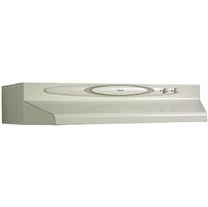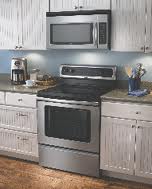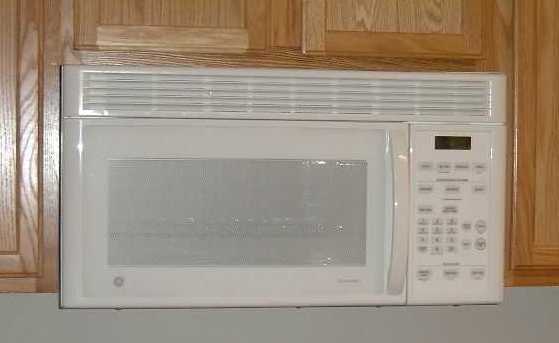 Installing a microwave oven in place of a range hood is a common upgrade. Not only is it very convenient, but it clears some space on your countertop.
Installing a microwave oven in place of a range hood is a common upgrade. Not only is it very convenient, but it clears some space on your countertop.
If there is currently a range hood in place, then there is already power in the cabinet above it. So it is a matter of removing the range hood and installing the microwave. Unplug the range hood and look below the hood. It will be held in place with four screws. The hood will drop down and as you remove it, thread the power cord through the hole in the underside of the cabinet and remove it.
The microwave will be considerably heavier. It is held in place by a bracket that is screwed to the wall. The key here is that at least one of the screws that hold the bracket to the wall must be in a wall stud. The others can be held with wall anchors (check with the manufacturer for the specifics). You will need to attach the cord to the unit and thread it through the hole where the old one went. Lift the microwave up and set it on the lip at the bottom of the bracket and then swing it up into place. You will install a screw through the cabinet bottom that mates with a hole in the top of the microwave (there is a template included in the box to mark the location). As you tighten the screw, the front of the microwave will rise up to meet the bottom of the cabinet.
By the way, microwaves are set up to recirculate the air back into the room through a charcoal filter. You can install it this way, or if the microwave is on an exterior wall, you can rotate the motor 90-degrees and run the venting up and out of the house.
 If you are installing a microwave hood over the range, you have to install a bracket that comes with the microwave. What we are seeing a lot of, is that residents of homes being foreclosed upon will take the microwave hood thinking they will either sell it or install it at a new property. The problem is that without the bracket, they won’t be able to mount it to the wall.
If you are installing a microwave hood over the range, you have to install a bracket that comes with the microwave. What we are seeing a lot of, is that residents of homes being foreclosed upon will take the microwave hood thinking they will either sell it or install it at a new property. The problem is that without the bracket, they won’t be able to mount it to the wall.
The brackets are specific to the microwave hood. In other words, I can’t install a Hotpoint microwave oven on a Magic Chef bracket. The brackets are not interchangeable. So if you are buying a new house and you see the microwave missing from the wall, but the bracket is still there, unless you buy the same unit, you will probably have to remove the old bracket and install the correct one that came with the new microwave.
Fortunately this isn’t hard to do. The new microwave will come with a paper template to hold against the wall. This will allow you to install the fasteners in the correct locations so as not to interfere with the microwave, but also to make sure it stays secure to the wall. There are diagrams on the template with various hole locations that allow you to insure at least one of the fasteners is secured into a wall stud, and others can use wall anchors.
 Having a microwave hood is a great feature. It sits right under your wall cabinet directly over your cook top or stove. When it is installed correctly it looks great, but how do you fix a gap in between the bottom of the cabinet and the top of the microwave?
Having a microwave hood is a great feature. It sits right under your wall cabinet directly over your cook top or stove. When it is installed correctly it looks great, but how do you fix a gap in between the bottom of the cabinet and the top of the microwave?
The microwave hood sits on a bracket that is screwed into the wall. The brunt of the weight and stability rests on this wall bracket. The power cord gets threaded through a hole in the cabinet above it. The final adjustment is closing this gap between the microwave and the cabinet.
If you look in the cabinet above the microwave, you will see a screwhead near the front of the opening. This screwhead is attached to a bolt that goes through the bottom of the cabinet and into the top of the microwave. The purpose of the bolt is to hold the front of the microwave and adjust the gap. By turning the screw clockwise, you will close the gap. Always support the microwave from below as you turn the screw, as this will make raising the microwave easier. You want to turn the screw just enough to close the gap. Don’t over tighten the screw.

Here is an easy way to add 3 square feet of counter space to your kitchen...remove the old microwave from the counter and install a microwave hood above your range. You won't have to change any cabinetry because microwave hoods and vent hoods are uniform in width.
Plan on spending at least $250 for a low-end microwave hood, and about 1 1/2 hours to install it.
First, you'll have to remove the old range hood, then unplug the electrical cord in the cabinet above the hood. Next, unscrew the four screws (or less if the original installer got lazy) that hold the hood in place (usually one at each corner). Support the hood as you do this.
Your new microwave will come with a paper template, which you'll tape to the wall and to the underside of the cabinet where the microwave will be mounted. The template shows where to drill holes in the wall to fasten the mounting bracket that supports the microwave. Under the cabinet, the template shows where to drill holes to allow the cord through and the location of the height adjustment screw.
There are two types of mounting brackets. One has "arms" on either side at the top, which the microwave slides onto. The other has a channel at the bottom that the base of the microwave rests in, and is fastened with the height adjustment screw. Whichever bracket you have, you'll have to secure it to a wall stud.
This is easy because a stud finder (about $10) will pinpoint the location. Mark the location on the template and pre-drill the holes according to the manufacturer's instructions. The rest of the bracket will be held to the wall using toggle bolts (molly bolts), which are included in the package.
Insert the bolts through the holes in the bracket, then twist on the toggle nut just enough so it doesn't fall off. Push the toggles through the pre-drilled holes in the wall. As you turn the toggle bolt with a screwdriver, you'll have to pull outward on the screw to engage the toggle and tighten the bracket to the wall.
If the stud doesn't line up with one of the corner holes, secure the bracket to the wall stud using a wood screw (it's also included) into one of the holes in the bracket that aligns with the stud.
If you have ductwork to connect the hood to, use sheet metal screws and foil tape. If there is no duct work above the hood, you'll be installing the microwave range hood so that it recirculates the exhaust, which is a fancy way of saying that it blows it back into the room. However, there is a charcoal filter that the exhaust passes through before it is recirculated.
The microwave range hood comes ready for attachment to a ducted system. If you have a ductless system, you'll need to remove the blower and turn it according to the manufacturer's instructions (don't worry, it's a matter of four screws).
Once the blower is oriented, attach the microwave to the bracket. This is awkward because you'll have to thread the power cord through the hole in the underside of the cabinet while you support the microwave. There is a temporary pin that will hold the microwave in place until you permanently fasten it to the bracket and the cabinet. It's much easier to have a helper support the microwave while you stick in the pin.
Make any final adjustments to the microwave then, while supporting it, remove the temporary pin and insert the height adjustment screw. You can close any gap between the top of the microwave and the bottom of the cabinet by tightening this screw.
Now you're ready to plug in the hood and program the time.